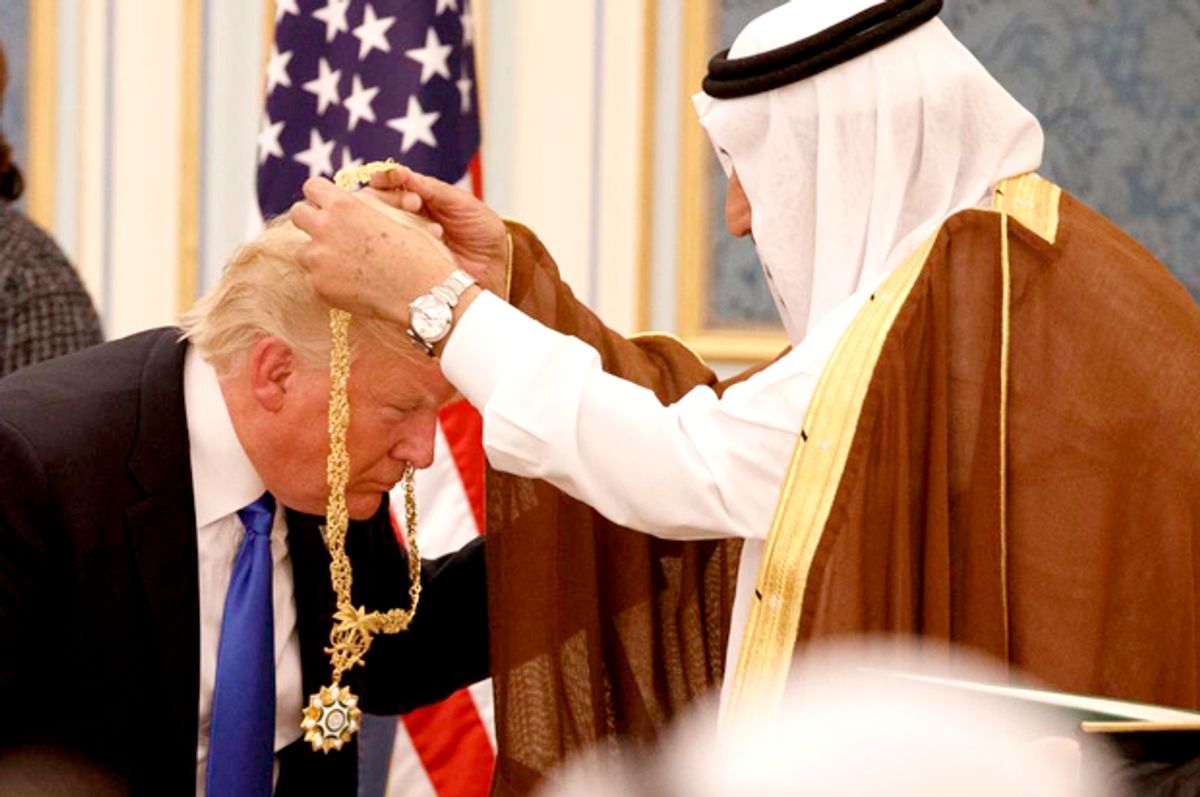This article was originally published on The Conversation. Read the original article.
President Donald Trump received both pageantry and a warm reception on his first trip to the Middle East.
Whether bowing his head to receive the King Abdulaziz al Saud Collar from Saudi Arabian King Salman, gathering around the “glowing orb” at the Global Center for Combating Extremist Ideology in Riyadh or standing at the Western Wall in Jerusalem, Trump played the leader of a superpower. His hosts went along.
King Salman and Israeli Prime Minister Benjamin Netanyahu wanted a warm, public interaction with the U.S. president, something neither had with former U.S. President Barack Obama. Trump delivered.
But in policy terms, the trip did not address how Trump will grapple with the core problems the United States has with each of these close allies, Saudi Arabia and Israel. Trump is an entertainer, not a diplomat. The Mideast leg of this trip reinforced that he values imagery over policy.
As an expert on U.S. policy in the Middle East and on Arab-Israeli relations, I think it is clear that Trump’s hopes for regional stability or an Israeli-Palestinian peace agreement – outcomes that require detailed policy – rest on shaky ground. Will he go beyond merely meeting Israeli and Saudi demands for positive public images and the exchange of kind words?
Helping Saudi Arabia, undermining Iran
On the question of challenging Iran’s alliances and regional leadership aspirations, Trump and Netanyahu spoke much more harshly than Obama. In his speech in Riyadh, Saudi Arabia, Trump said, “Iran has fueled the fires of sectarian conflict and terror. It is a government that speaks openly of mass murder, vowing the destruction of Israel, death to America, and ruin for many leaders and nations in this room.”
But Trump has not yet tried to undo the 2015 Iran nuclear agreement, despite his campaign promises. Perhaps he will try to squeeze the agreement indirectly by increasing sanctions against Iran on the basis of other issues, such as terrorism or human rights violations. But squeezing Iran would be a tough sell to U.S. rivals like Russia and China, or even major European allies who generally like the existing agreement with Iran.
Still, Trump’s visit to Riyadh made clear he is firmly on Saudi Arabia’s side in its regional cold war with Iran. Iran and Saudi Arabia both aspire to be the leading power in the Middle East. They aren’t fighting each other directly, but rather by arming and aiding allies in civil wars in nearby Syria and Yemen.
Trump’s deepening of the U.S. commitment to Saudi Arabia was most tangibly signaled by the massive arms commitment and the disinterest in both democracy and human rights questions or any public discussion of Saudi Arabia’s role in the war in Yemen.
Trump’s short time in Saudi Arabia left the central contradiction of his approach unexplored. In Trump’s words, the United States will successfully achieve “the aim of stamping out extremism” with Saudi Arabia as a lead partner.
But how is that feasible when Saudi Arabia’s repressive regime, ideology and wealth have helped create the environment in which Islamist extremism thrives? The Saudi government is a dictatorship lacking protections for free speech or a free press. Moreover, though U.S.-Saudi cooperation on the matter has improved in recent years, private Saudi money has flowed to violent radicals, including al-Qaida.
Israeli-Palestinian peace?
With the Israeli government, Trump changed the tone and atmospherics compared with Obama. Trump and the Israeli prime minister have similar worldviews and, in public, seem genuinely excited to be working together.
But even with this visit to Israel, it remains unclear how much U.S. policy will shift. Like Obama and many previous U.S. presidents, Trump has pressed Israel to curtail settlement construction in the West Bank. He seems interested in solving the Israeli-Palestinian conflict and creating peace, as he told both Netanyahu and Palestinian President Mahmoud Abbas, although no process is yet apparent.
Is it bluster or substance?
It’s hard to tell. On this trip, Trump avoided mentioning a two-state solution, the usual proposal offered to address competing Israeli and Palestinian demands. Perhaps Trump hopes Arab states will put pressure on Palestinians in order to achieve some other kind of regional peace deal, but he and his advisers offered no concrete plan.
![]() In the next year or two, the Trump administration will have to make choices about its Middle East policy. Either warmly embrace Saudi Arabia or comprehensively address the roots of extremism. Either warmly embrace the Israeli government and its distaste for a two-state solution, or pursue Israeli-Palestinian peace. If the administration wants to use this trip to develop actual U.S. policy, it will need to make hard choices and offer specific details.
In the next year or two, the Trump administration will have to make choices about its Middle East policy. Either warmly embrace Saudi Arabia or comprehensively address the roots of extremism. Either warmly embrace the Israeli government and its distaste for a two-state solution, or pursue Israeli-Palestinian peace. If the administration wants to use this trip to develop actual U.S. policy, it will need to make hard choices and offer specific details.
Jeremy Pressman, Associate Professor of Political Science, University of Connecticut



Shares